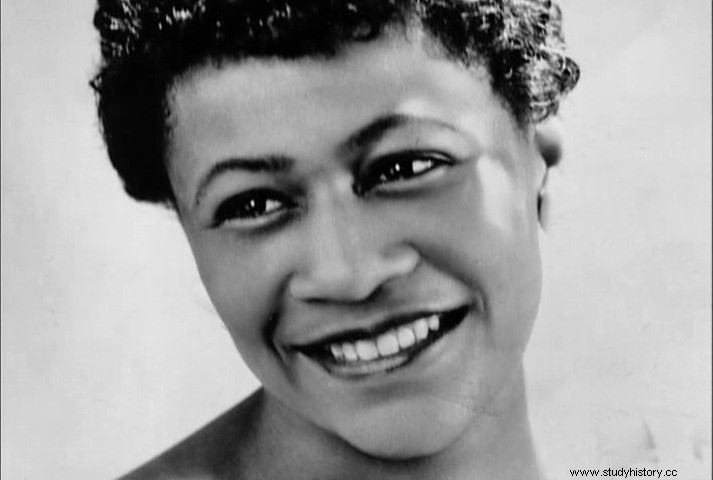Ella Jane Fitzgerald (1917 – 1996) was an American jazz singer, known by the nickname "The First Lady of Song" and renowned for the purity of her voice and her improvisational abilities.
The beginnings of a singer
 Daughter of Temperance and William Fitzgerald, Ella Jane Fitzgerald was born on April 25, 1917, in Newport News, Virginia. Her mother works in a laundry and her father abandons her family when Ella is not yet a year old. With her mother and her new companion, Joseph Da Silva, Ella settled and grew up near New York. His half-sister, Frances, was born in 1923.
Daughter of Temperance and William Fitzgerald, Ella Jane Fitzgerald was born on April 25, 1917, in Newport News, Virginia. Her mother works in a laundry and her father abandons her family when Ella is not yet a year old. With her mother and her new companion, Joseph Da Silva, Ella settled and grew up near New York. His half-sister, Frances, was born in 1923.
Ella took an early interest in dancing, which she practiced whenever she could, on the way to school and during lunch break. Passionate about music, she enjoys listening to recordings by Louis Armstrong and Connee Boswell. A Methodist, she was invested in the Bethany African Methodist Episcopal Church and experimented with music there. In 1932, Temperance Fitzgerald died of a heart attack. Following the shock, Ella's school results drop and she begins to skip school. To escape her stepfather who abuses her, she flees to an aunt before being placed in an orphanage. She ends up running away again and will be homeless for a while.
Ella made her debut as a singer at the age of 16, at the Apollo Theater in Harlem, New York. During an “Amateurs Nights”, she performed two titles by Connee Boswell and won the prize. In January 1935, following an audition, she performed for a week with Tiny Bradshaw at the Harlem Opera House, and met Chick Webb's group there. She began to sing regularly with them and recorded several hits that made her known, including:If You Can't Sing It, You'll Have to Swing It , Love and Kisses , and A Tisket, a Tasket . In 1939, Chick Webb died and the group was renamed "Ella Fitzgerald and Her Famous Orchestra ". They will record almost 150 songs before going their separate ways.
Career and success
In 1941, Ella Fitzgerald married Benny Kornegay but the marriage was annulled two years later. In 1942, she left her group to start a solo career, while performing with many groups and artists. First a swing singer, she also explores bebop, scat where she is very talented, blues, samba and gospel. Through these different styles, she develops and deepens her vocal abilities. His very creative scat improvisations are very popular. The same year, she appeared in the comedy film Deux nigauds cowboys . Later, she will also star in Pete Kelly's Blues, Ride ‘Em Cowboy , St. Louis Blues , and Let No Man Write My Epitaph .
In 1947, Ella remarried Ray Brown, with whom she adopted her half-sister Frances' son; they divorced in 1953. In 1955, Marilyn Monroe gave a boost to Ella's career by imposing her at the Mocambo Club in Los Angeles. The same year, Ella left her record company, Decca, in 1955, and her manager, Norman Granz, created the company Verve for her.
Tours around the world
Between 1956 and 1964, Ella Fitzgerald recorded with Verve eight musical collections with songs written by great composers such as George Gershwin, Cole Porter and Duke Ellington. With the Duke Ellington Orchestra, she tours Europe and North America. With Louis Armstrong, she recorded three very popular albums:Porgy and Bess , Ella and Louis and Ella and Louis Again .
In 1985, Ella was briefly hospitalized with respiratory problems. She was then in 1986 for heart failure and then in 1990 for overwork. In 1993, his diabetes, which affects his vision, forced doctors to amputate both legs below the knees. In 1996, she refused to stay in the hospital and spent her last days at home with her son and granddaughter. Ella Fitzgerald died of a heart attack on June 15, 1996, at the age of 79.
She is enshrined in the National Women's Hall of Fame.
